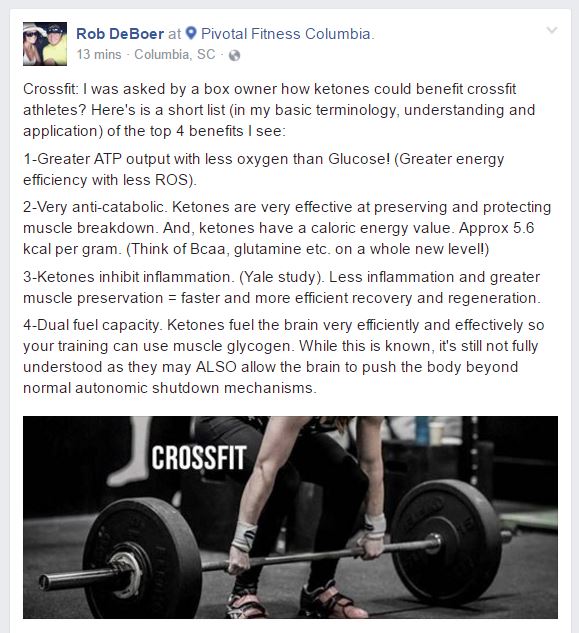
Crossfit And Ketones: How can they help?
If you do Crossfit and you do it on the regular, there are a few things you probably have your attention on. Peak performance and quick recovery. But you may also have some genuine interest in endurance (both aerobic and anaerobic) and strength. You may have also heard of supplemental ketones as a way to help with all of these. Maybe you’ve heard a podcast about ketones and their benefits but you’re still thinking, “well yeah, but I do Crossfit, how does that apply to me?”
Well, here you go! We’re going to look at Crossfit and ketones and how they can help you go harder, longer and faster.
Going to site a post from Facebook (seems legit – LOL) from my buddy Rob DeBoer. He posted the following to his page which I’ll quote in it’s entirety first them comment second.
Crossfit And Ketones: How can they help?

Crossfit: I was asked by a box owner how ketones could benefit Crossfit athletes? Here’s is a short list (in my basic terminology, understanding and application) of the top 4 benefits I see:
1-Greater ATP output with less oxygen than Glucose! (Greater energy efficiency with less ROS).
2-Very anti-catabolic. Ketones are very effective at preserving and protecting muscle breakdown. And, ketones have a caloric energy value. Approx 5.6 kcal per gram. (Think of BCAAs, glutamine etc. on a whole new level!)
3-Ketones inhibit inflammation. (Yale study). Less inflammation and greater muscle preservation = faster and more efficient recovery and regeneration.
4-Dual fuel capacity. Ketones fuel the brain very efficiently and effectively so your training can use muscle glycogen. While this is known, it’s still not fully understood as they may ALSO allow the brain to push the body beyond normal autonomic shutdown mechanisms.
Crossfit And Ketones: Top 4 benefits
So let’s break this down.
1 -Greater ATP output
Adenosine triphosphate (ATP) in a nutshell is the energy in a cell. Any cell, but where it matters to you most, a muscle cell. The more ATP a muscle cell has, the better it can function. Remember the creatine craze? Creatine helps with more ATP which results in greater cellular output which leads to a better performing muscle which will also result in more muscle. The “issue” comes with the byproduct of cellular metabolism and oxidative stress. Think browning apples and avocados. Keeping it as simple as possible, because there’s a lot of scientific gobbledygook here, an imbalance of oxidative stress will impair all recovery. Not just post-workout but between sets and during sets.
When your body is using ketones for fuel instead of glucose, you get more ATP with less oxidative stress and that’s great news for a Crossfit athlete. Think about the time moving from one drill to the next or when out on a long, hard run, you adjust pace with out stopping to recover. All of this is impacted by your body’s ability to handle free-radicals and oxidative stress in the moment.
From personal experience: Since starting supplementing with Keto//OS, I can train longer and harder. Muscular endurance is up and I can keep going even after I “gas out.” When I was dependent on glucose, gassing out meant I was done. Not anymore.
2 – Very anti-catabolic
Catabolic in this instance is the breakdown of muscle. Typically, you become catabolic in the absence of sugar. If your body is dependent on sugar (glucose) as it’s primary fuel source, it will make its own sugar if you’re not supplying it. There are certain amino acids which are glucogenic, meaning your body can convert the amino acid into sugar and use it for fuel. So if you’re out of sugar and not consuming it, it’s coming from your muscles. This can happen during a workout and also during the day. Anytime you blow out of sugar. That’s also when the headache starts, the mood takes a dump and all that low-blood sugar crap.
Glutamine is the most abundant amino acid in the body and also very glucogenic which makes it anti-catabolic for sugar burners. There are three BCAAs (branched chain amino acids). They can promote muscle protein synthesis and increase muscle growth over time. It can also be used to prevent fatigue. The main BCAA is Leucine. This is a very interesting amino and will get it’s own post soon, but for now, know this; Leucine is highly anti-catabolic and it’s not a glucogenic amino acid. It’s a ketogenic amino acid, meaning it can’t be converted to sugar, it can only convert into a ketone. This is why Keto//OS BioMax has Leucine in it. So for Crossfit, using Keto//OS before training will keep you using your muscles instead of breaking them down for fuel.
From personal experience: As noted above, I’ve got more gas in the tank when hitting the workouts hard, but what’s most interesting is since getting on Keto//OS and taking it once – twice daily, not only have I enjoyed some real body comp changes, I don’t get the mid-day crash like I used to. Why is that valuable? You don’t get strong in the gym, you don’t build muscle in the gym. The gym is where you break it down. You build muscle when you’re recovering, sleeping and not being active. That’s an all day thing. More energy throughout the day means I am recovering better from my training. And it’s happening without sugar and in caloric restriction. Using fat and ketones for fuel instead of sugar preserves muscle and keeps energy high throughout the day and powers the workouts.
3 – Ketones inhibit inflammation
Inflammation is part of healing. Inflammation is actually a good thing. But, as we are all so fond of saying, there is such a thing as too much of a good thing. Inflammation that becomes systemic opens you up to real disease (think cancer) and also the key signs of overtraining. If your nutrition and recovery is on point, there is no overtraining. Minimizing systemic inflammation is another component to faster recovery and greater work capacity.
From the Yale study: “In their study, published in the Feb. 16 online issue of Nature Medicine, the researchers described how the compound β-hydroxybutyrate (BHB) directly inhibits NLRP3, which is part of a complex set of proteins called the inflammasome. The inflammasome drives the inflammatory response in several disorders including autoimmune diseases, type 2 diabetes, Alzheimer’s disease, atherosclerosis, and autoinflammatory disorders.”
From personal experience: I supplement with Keto//OS and also take Krill Oil at bedtime for this exact reason. Since making this adjustment, my sleep has improved and I am recovering better and faster. I also feel better and that has made all the difference in my training as well.
4-Dual fuel capacity.
Crossfitters, this is the last one and should get you off the fence on whether or not crossfit and ketones are a great idea. What does Rob mean by “dual fuel capacity?” Your brain needs energy to function optimally too. Since starting Keto//OS, I’ve noticed faster reaction times at work, way less “brain fog” and increased mental energy. Rob says, “Ketones fuel the brain very efficiently and effectively so your training can use muscle glycogen. While this is known, it’s still not fully understood as they may ALSO allow the brain to push the body beyond normal autonomic shutdown mechanisms.”
Wait, what did he say? Autonomic shutdown mechanisms? Huh? Definition of autonomic: involuntary or unconscious; relating to the autonomic nervous system. It’s like a regulator on a car’s engine. Here’s the deal with this, in a book called “Living With A SEAL” by Jesse Itzler, SEAL points out that when you think you’re done, you’re only 40% done. Meaning there’s another 60% left in the tank. You’re body and mind has a regulator to keep you from harming yourself. Sometimes under periods of extreme stress or narcotic intervention you’ll here of people exhibiting feats of great strength. A grandmother deadlifting a Jeep to save her granddaughter or a guy on PCP breaking free of handcuffs. This happens because the regulator got turned off for a second.
What if you could override the regulator? You can train through that. Both Pavel Tsatsouline and Wim Hof have talked about this in their books listed below. Being able to push past a perceived limit stacked with a method of enhanced recovery that isn’t on USADA’s long ass list of banned substances is a pretty sweet combo if you asked me. Especially when you train hard, explosive and often.
From personal experience: I’m 43 years old and in the best shape of my life. I’ve never felt this good about my physical strength and conditioning. My output is like never before. I can go past places I know I would have quit before. I don’t gas out and I don’t chicken out. Remember how I mentioned faster reaction times at work, way less “brain fog” and increased mental energy? The traditional ketogenic diet helps with epilepsy. Those ketones are good for your brain and the better it works, the better you work.
What kind of results are you seeing? Comments and questions welcome below.
CLICK HERE to try Keto//OS
For Further Reading:
- The Primal Blueprint by Mark Sisson
- Living With A SEAL by Jesse Itzler
- Power To The People by Pavel Tsatsouline
- Becoming The Ice Man by Wim Hof